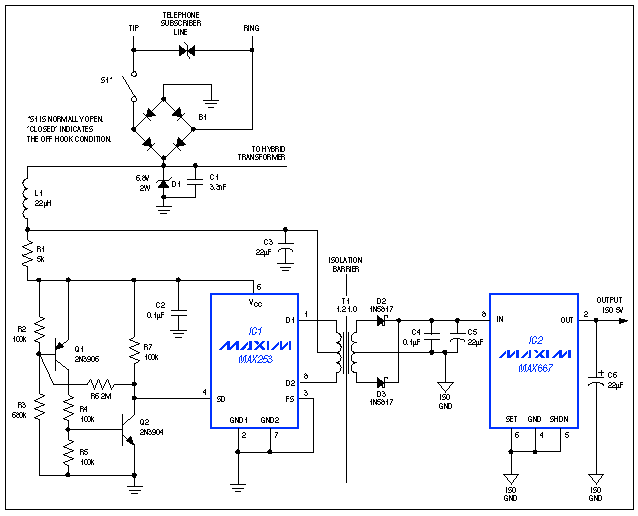
IntroductionThis application note is intended to show how the 3-wire extended system information bus (ESIB) function allows the interrupt status or other user-selectable alarm status information for multiple single-chip transceivers (SCTs) to be accessed in a single read cycle. This allows for streamlined access of certain status registers from a group of up to eight SCT ports with the host not needing to poll each port separately. The ESIB feature was first available on the DS2155 and DS21Q55, but any product with this feature can participate in an ESIB group because all SCTs within an ESIB group are independent from each other.
Extended System Information Bus (ESIB)ESIB allows up to eight SCT ports to share an 8-bit CPU bus for reporting alarms and interrupt status as a group with a single bus read. There are two control registers (ESIBCR1 and ESIBCR2) and four information registers (ESIB1, ESIB2, ESIB3, and ESIB4). For example, eight DS2155s (or two DS21Q55s) can be grouped into an ESIB group. A single read of the ESIB1 register of any member of the ESIB group yields the interrupt status of all eight ports. Through ESIB2, the host can gather synchronization status for all members of the group. ESIB3 and ESIB4 can be programmed to report various alarms on a port-by-port basis. There are three device pins involved in forming an ESIB group: ESIBS0, ESIBS1, and ESIBRD. A 10kΩ pullup resistor must be provided on ESIBS0, ESIBS1, and ESIBRD. Figure 1 shows an example of four DS2155 devices connected in an ESIB group.
mode for alarm and status reporting.
mode for alarm and status reporting.
mode for alarm and status reporting.

Figure 1. ESIB pin connection.
Interrupt HandlingStatus registers are the only sources of interrupts in devices with the ESIB feature. On power-up, all writeable registers are automatically cleared. Since bits in the IMRx registers have to be set = 1 to allow a particular event to cause an interrupt, no interrupts can occur until the host selects which events are to product interrupts. Since there are potentially many sources of interrupts, several ESIB functions are available to help sort out and identify which event is causing an interrupt. When an interrupt occurs, the host should first read the IIR1 and IIR2 registers (interrupt information registers) to identify which status register (or registers) is producing the interrupt. Once that is determined, the individual status register or registers can be examined to determine the exact source. Once an interrupt has occurred, the interrupt handler routine should set the INTDIS bit (CCR3.6) to stop further activity on the interrupt pin. After all interrupts have been determined and processed, the interrupt hander routine should re-enable interrupts by setting the INTDIS bit = 0.
Bit 0/Extended System Information Bus Enable (ESIEN)0 = disabled
1 = enabled
Bits 1 to 3/Output Data Bus Line Select (ESIBSEL0 to ESIBSEL2). These bits tell the SCT what data bus bit to output the ESIB data on when one of the ESIB information registers is accessed. Each port in the ESIB group must have a unique bit selected.
Bits 4 to 7/Unused, must be set to 0 for proper operation
Bits 0 to 2/Address ESI3 Data Output Select (ESI3SEL0 to ESI3SEL2). These bits select what status is to be output when the SCT decodes an ESI3 address during a bus read operation.
Bit 3/Unused, must be set to 0 for proper operationBits 4 to 6/Address ESI4 Data-Output Select (ESI4SEL0 to ESI4SEL2). These bits select what status is to be output when the SCT decodes an ESI4 address during a bus read operation.
Bit7/Unused, must be set to 0 for proper operation
Bits 0 to 7/Device Interrupt Status (DISn). Causes all devices participating in the ESIB group to output their interrupt status on the appropriate data bus line selected by the ESIBSEL0 to ESIBSEL2 bits of the ESIBCR1 register.
Bits 0 to 7/Device Receive Loss-of-Sync (DRLOSn). Causes all devices participating in the ESIB group to output their frame synchronization status on the appropriate data bus line selected by the ESIBSEL0 to ESIBSEL2 bits of the ESIBCR1 register.
Bits 0 to 7/User-Selected Status 1 (UST1n). Causes all devices participating in the ESIB group to output status or alarms as selected by the ESI3SEL0 to ESI3SEL2 bits in the ESIBCR2 configuration register on the appropriate data bus line selected by the ESIBSEL0 to ESIBSEL2 bits of the ESIBCR2 register.
Bits 0 to 7/User-Selected Status 2 (UST2n). Causes all devices participating in the ESIB group to output status or alarms as selected by the ESI4SEL0 to ESI4SEL2 bits in the ESIBCR2 configuration register on the appropriate data bus line selected by the ESIBSEL0 to ESIBSEL2 bits of the ESIBCR2 register .
欢迎分享,转载请注明来源:内存溢出

 微信扫一扫
微信扫一扫
 支付宝扫一扫
支付宝扫一扫
评论列表(0条)